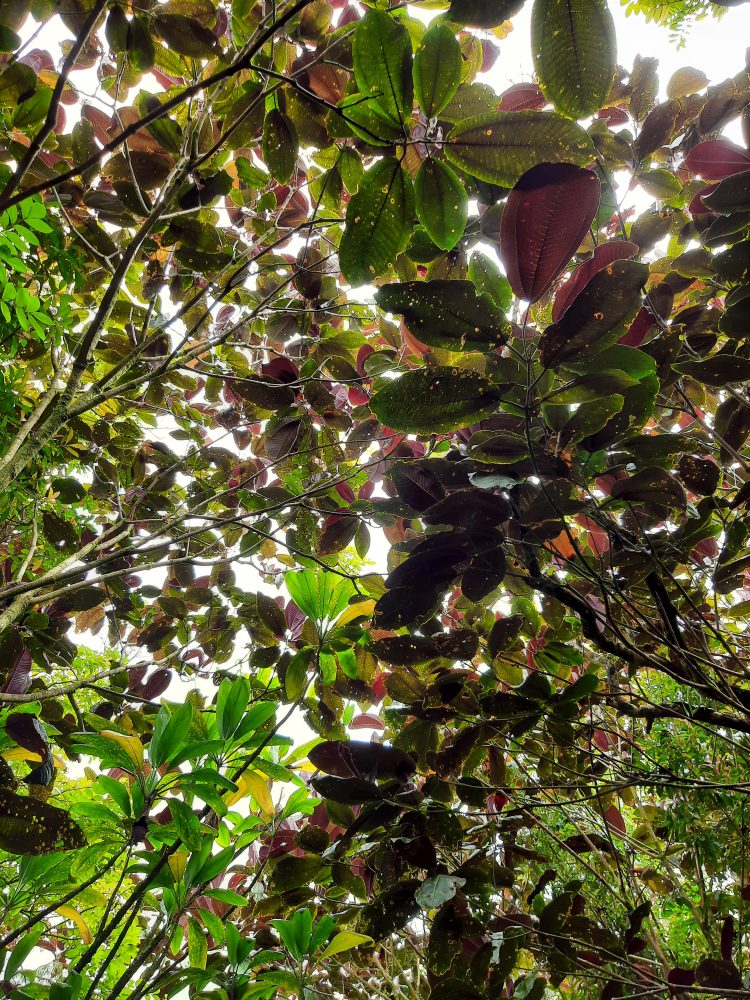
*Denotes designation as a Hawaii State Noxious Weed. Regulations prohibit the intentional propagation and distribution of this plant.
(Miconia calvescens)
Family: Melastomataceae
Considered very invasive and is on the Hawaii State Noxious Weed List.
The Division of Forestry and Wildlife of the Hawaii Department of Land and Natural Resources has designated this species as one of Hawaii’s Most Invasive Horticultural Plants.
Description:
- Large tree grows up to 50 feet tall
- Large oval-shaped leaves, green on top, purple underneath, with three main midribs running from stem to leaf-tip
- Small, purple berries containing seeds are spread mainly by birds
- Native to South and Central America, introduced to Hawaii as a garden plant in 1961 and spread around by plant enthusiasts



Harm:
- Forms thick stands, shades out native plants and completely takes over moist and wet forests
- Forms an “umbrella” over the watershed, potentially reducing the amount of rainwater that seeps into the watershed.
- Shallow root systems promote erosion
- Can grow from seed to mature seeding tree in four years. A mature tree can produce about 3 million seeds several times per year. Seeds can remain viable for 10 or more years before sprouting
- Sand-grained sized seeds easily spread by birds and other animals when they eat the fruit. Seeds also spread by people when contaminated dirt or mud sticks to shoes, clothing, equipment, or vehicles
- Introduced to Tahiti in 1937 and has since overwhelmed two-thirds of Tahiti’s forests, and is directly responsible for threatening 25% of their native forest species with extinction


In Hawaiʻi:
- Kauaʻi – There are three known populations, in Wailua River State Park, Wailua Homesteads, and the Wailua Game Management Area. The Kauaʻi Invasive Species Committee works with partners to survey for and control all known miconia on Kauaʻi. Land owners and tenants can allow KISC to survey their property and eradicate miconia.
- Oʻahu – Originally introduced and traded amongst botanical gardens in the early 1960’s, miconia has since spread into several locations in the Koolau range. The potential population boundary extends to 9,500 acres (including areas considered “seed banks”). If left uncontrolled, miconia could infest up to 121,300 acres on Oʻahu. The Oʻahu Invasive Species Committee is working to survey all population boundaries to completely eradicate it from Oʻahu.
- Maui – Introduced to Maui in the early 1970s at a private nursery and botanical gardens near Hāna. Infestations now occur in the forests near Hāna, Nāhiku, Keʻanae, and Huelo. Today, approximately 37,000 acres throughout East Maui, could potentially contain miconia. Not known from West Maui.
- Molokai – Miconia is not known to be present at this time. Seeds could arrive in soil on hiker’s or hunter’s shoes or gear, or on native tree fern logs imported from the Big Island. The Molokai/Maui Invasive Species Committee educates community members to aid in early detection.
- Lānaʻi – None known.
- Kahoʻolawe – None known.
- Hawaiʻi Island- Widespread on Hawaiʻi Island. The Big Island Invasive Species Committee (BIISC) will control in high-value native forest areas, otherwise, control is dependent upon the landowner. If you live on Hawaiʻi Island and want to control miconia on your property, visit BIISCʻs page here.



For more information, see:
- Miconia calvescens information from Hawaii Invasive Species Committee
- Miconia information from Plant Pono
- KISC’s miconia survey and eradication program
- MISC’s 2009 International Miconia Conference


